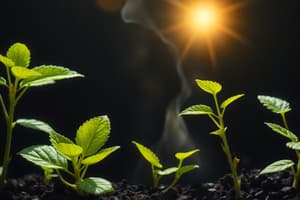Podcast
Questions and Answers
Which of the following are autotrophs? (Select all that apply)
Which of the following are autotrophs? (Select all that apply)
- Leopards
- Implants
- Plants (correct)
- Mushrooms
One of the principal chemical compounds that living things use to store energy is?
One of the principal chemical compounds that living things use to store energy is?
- ATP (correct)
- H2O
- DNA
- CO2
Which scientist concluded that most of a growing plant's mass comes from water?
Which scientist concluded that most of a growing plant's mass comes from water?
- Calvin
- Priestley
- Van Helmont (correct)
- Ingenhousz
In addition to light and chlorophyll, photosynthesis requires?
In addition to light and chlorophyll, photosynthesis requires?
The leaves of plants appear green because chlorophyll?
The leaves of plants appear green because chlorophyll?
The products of photosynthesis are?
The products of photosynthesis are?
Which organelle contains chlorophyll?
Which organelle contains chlorophyll?
The first process in the light-dependent reactions of photosynthesis is?
The first process in the light-dependent reactions of photosynthesis is?
Which substance from the light-dependent reactions of photosynthesis is a source of energy for the Calvin Cycle?
Which substance from the light-dependent reactions of photosynthesis is a source of energy for the Calvin Cycle?
The light-independent reactions of photosynthesis are also known as?
The light-independent reactions of photosynthesis are also known as?
How do heterotrophs and autotrophs differ in the way they obtain energy?
How do heterotrophs and autotrophs differ in the way they obtain energy?
Describe the three parts of an ATP molecule.
Describe the three parts of an ATP molecule.
Use the analogy of a battery to explain how energy is stored in and released from ATP.
Use the analogy of a battery to explain how energy is stored in and released from ATP.
Compare the amounts of energy stored in ATP and glucose. Which compound is used by the cell as an immediate source of energy?
Compare the amounts of energy stored in ATP and glucose. Which compound is used by the cell as an immediate source of energy?
How were Priestley's and Ingenhousz's discoveries about photosynthesis related?
How were Priestley's and Ingenhousz's discoveries about photosynthesis related?
Write the basic equation for photosynthesis using the names of the starting and final substances of the process.
Write the basic equation for photosynthesis using the names of the starting and final substances of the process.
What role do plant pigments play in the process of photosynthesis?
What role do plant pigments play in the process of photosynthesis?
What is the role of ATP synthase? How does it work?
What is the role of ATP synthase? How does it work?
Explain the role of NADP+ as an energy carrier in photosynthesis.
Explain the role of NADP+ as an energy carrier in photosynthesis.
Summarize what happens during the Calvin Cycle.
Summarize what happens during the Calvin Cycle.
How do the events of the Calvin Cycle depend on the light-dependent reactions?
How do the events of the Calvin Cycle depend on the light-dependent reactions?
Describe three factors that affect the rate at which photosynthesis occurs.
Describe three factors that affect the rate at which photosynthesis occurs.
Flashcards are hidden until you start studying
Study Notes
Autotrophs and Heterotrophs
- Autotrophs, such as plants, produce their own energy using sunlight.
- Heterotrophs, like leopards, obtain energy by consuming other organisms.
Energy Storage in Cells
- ATP (adenosine triphosphate) is the primary energy carrier in cells.
- ATP consists of adenine, ribose (a sugar), and three phosphate groups, functioning like a rechargeable battery.
Photosynthesis Basics
- Photosynthesis equation: Carbon dioxide + Water → Oxygen + Glucose.
- Photosynthesis occurs in chloroplasts, which contain chlorophyll—the pigment that absorbs sunlight and gives leaves their green color.
- Essential components for photosynthesis include water and carbon dioxide, alongside light and chlorophyll.
Photosynthesis Processes
- Light-dependent reactions convert light energy into chemical energy, producing ATP and NADPH.
- Light-independent reactions, known as the Calvin Cycle, utilize ATP and NADPH to synthesize glucose from carbon dioxide.
Important Scientists
- Van Helmont determined that most of a plant's mass comes from water.
- Priestley and Ingenhousz established that light is necessary for oxygen production in plants.
Energy Comparison
- Glucose stores more than 90 times the energy of ATP, making it a more efficient long-term energy source for cells.
- ATP is used as an immediate energy source.
Factors Affecting Photosynthesis
- The rate of photosynthesis is influenced by sunlight, water availability, and temperature.
Role of NADP+
- NADP+ acts as an energy carrier by transporting hydrogen atoms from light-dependent reactions, facilitating energy transfer within the process.
ATP Synthase Function
- ATP synthase utilizes high-energy electrons to produce ATP during the light-dependent reactions, helping to generate energy for the Calvin Cycle.
Calvin Cycle Summary
- The Calvin Cycle depends on products from light-dependent reactions, using ATP and NADPH to build high-energy compounds that can be stored for future use.
Studying That Suits You
Use AI to generate personalized quizzes and flashcards to suit your learning preferences.




